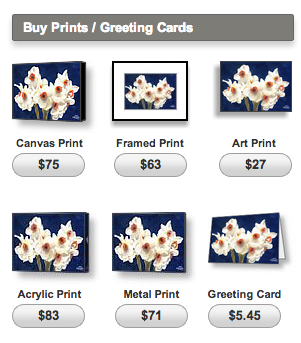Frequently, I am approached by people who have taken the exciting step of uploading their artwork to a Print on Demand website (POD) and have been sitting patiently awaiting their first sale.

Some write with tales of disappointment while others simply wonder how to proceed when the print sales never occur. The expectation is that simply uploading work to a POD site such as Fine Art America, Imagekind, or RedBubble will automatically result in sales.
The answer is always the same: self-promotion.
Unfortunately, there are thousands of other artists who are doing the same thing. The internal search engines for the POD sites almost always weight their results to favor specific artists that are felt to best represent the site’s image and clientele. This can often leave very talented artists and quality work buried under several pages of search results and hidden from the eyes of potential purchasers.
- By self-promoting, however, an artist can easily eliminate a POD site’s internal search engine and drive traffic to their own artwork.
- Viewing the Print on Demand site as simply a print fulfillment service is a much more realistic approach.

The more artwork that exists on a Print on Demand website, the more potential sales there are for the company itself. This tends to primarily benefit the POD site and not necessarily the individual artists since the POD companies are interested in selling a maximum number prints and not specifically who the artists are. From a profit standpoint, the more artists that belong to the service, the better it is for the POD company and the worse it is for the individual member. Because of this, self-promotion is the way to separate oneself from the pack.
- By driving your own traffic to your artwork, more people see the work and the probability of a sale is greatly increased.
- Additionally, some of the POD sites rank artists in search results based upon the number of views their work has received.
- By supplying your own viewers, you also can change how frequently your work appears within a POD site’s own search results.
Once a philosophy of self-promotion has been accepted, it is then a matter of how to proceed. I tend to utilize social-media for my promotional purposes but many favor email campaigns, newsletters, postcards, or other avenues. The advantage of using social-media, however, is that it is generally free, can reach a large number of people quickly, and has the added benefit of viral shareability of information.
Coupling some easy posting concepts with a clear networking strategy can streamline one’s social marketing approach and help generate more sales.
One of the first things to remember about a social-media marketing approach is that a continual bombardment of marketing posts can appear to viewers as spam. ~Ken Powers
Anyone who has done any marketing research will be familiar with the Pareto Principal. This principal simply states that marketing approaches through social-media should be broken into 80% social interaction or cross-promotion and 20% self-promotion. Some experts even recommend skewing the ratio to a 90/10 split. The Pareto Principal is a great general guideline to follow although some social-media networks can tolerate more self-promotion than others.
Every social-media network endeavor begins with establishing relationships.
- You can’t just sign up for a service and expect people to follow you.
- You have to begin by following and interacting with the posts of other members as you attempt to garner followers.
- Sharing, commenting, liking, and establishing friendships is the key to building a base of followers.
- Utilizing lists and other sharing tools that many social-media services provide can quickly help build a follower base.
- Under no circumstances, however, should one attempt to purchase followers through services that claim to provide instant results.
- There is no substitute for putting in the work to establish organic, legitimate relationships with real people.
- Most often, follower-purchasing services provide fake followers that will do nothing but increase a visible number but will never create sales or relationships.

Twitter is one of my personal favorite social-media channels to explore. I have had more success with this network than any other and although your mileage may vary, properly utilizing this service can significantly increase traffic to your artwork on a POD site.
- Due to Twitter’s constant stream of posts, it can easily withstand more self-promotional postings than nearly any other network that currently exists.
- Since posts aren’t prioritized for the user’s viewing pleasure, each promotional post is dropped into the stream at different times and reaches different audiences.
- With the addition of sharing via one’s established network, it is possible to reach a large number of people over a very short amount of time.
- I have found that whenever I announce a new piece of artwork, it is most effective for me to notify followers once in the morning, once at noon, once in the evening and once the following morning. More than that leads to diminished returns and risks appearing spammy.
- I offset my self-promotional posts by recommending people to follow on Fridays and by promoting fellow artists and collectors.
Facebook, conversely doesn’t seem to respond as well to repeated self-promotional posts.
- Much of this has to do with the manner in which Facebook prioritizes and presents posts to followers.
- When posts are repeatedly made and aren’t interacted with, they are deemed to be less desirable by the Facebook prioritization algorithms and are therefore shown less and less in followers’ news feeds.
- It is interesting to note that self-promotional posts on my Facebook Page that pertain directly to my artwork reach about 30% of my followers.
- Cross-promotional posts tend to only reach about 4% and event posts tend to only reach about 2%.
- Much of this is because I have taken care to establish a balanced ratio of posts but my viewership is less interested in the cross-promotional stuff as far as the Facebook algorithms are concerned.
- However, if I up the number of personal posts by too much, my self-promotional reach will be reduced as well. Services such as Facebook that utilize an algorithmic based ranking system for the information delivered to viewers need to have their analytics carefully observed in order to determine how frequently to post while maximizing viewership reach. It is necessary to experiment in order to determine which posts are the most effective for each individual artist.
As can be seen above, different networks respond differently to varying amounts of self-promotion. The good news is that all current social networks seem to adhere to one of the two models mentioned above. Either they prioritize posts, or they just let them flow by. Once the model is identified, the number of self-promotional posts that one can make without appearing spammy becomes fairly obvious. Establishing the proper ratio of posts for each network utilized will maximize its effectiveness and generate the most traffic to one’s POD site artwork.
Although it is not possible to address every social-network and situation in this simple blog post, it is important to note how effective social-media marketing can be. By driving traffic to artwork on a Print on Demand site, the site’s internal search engine and prioritization is minimized and the chances of creating a sale are maximized. Remember, people don’t purchase work which they don’t know exists…..so let them know about it!
Guest artist/author: Ken Powers is a still-life watercolorist from Tacoma, Washington. His paintings can be found in numerous public and private collections throughout the world, including ABC Studio’s hit television series “Desperate Housewives.”
*****
*Thanks Ken, for sharing this valuable information! I am new to POD, and your tips will help me too. Be sure and check out and my fine art prints and notecards on Fine Art America.!. I’d also love to meet you on my art website, LoriMcNee.com, on Facebook Fine Art Tips Facebook Fan Page, on Twitter, Google Plus and on Pinterest. ~Lori








This is interesting, because I am involved with the Spoonflower.com site that prints on natural fabrics, wallpaper and now decals. I try to do some promoting on FB and twitter. I also sell some on Etsy. I am active in the Spoonflower forum on Flickr where I get to interact with other designer.
Hello Kathy, I haven’t heard of Spoonflower, but will look it up. Thanks for sharing your information here with us. Happy to have you stop by for a comment.
Lori 🙂
Great piece… thanks Ken (and Lori) for posting it. Lots of people grappling with these issues… myself included. FB has been a disappointment for me in terms of self-promo but as my Twitter followers grow, I’m beginning to see some traction there.
Hello John, yes all these sites can work well together! I have started to sell a few prints myself and am quite excited about it. 🙂
Thanks, Lori, for continuing to provide top-notch posts for artists.
Excellent run-down, Ken! I agree and have found very similar results regarding POD and social media returns. (I have one friend who thinks that self-promotion of a POD means posting it once on Facebook. Oops.)
Hi Stan, are you a visual artist as well as a musician? If so, my apologies for not knowing this! Haha…yes, we have to be careful of posting high resolutions on FB and the other sites. Good seeing you.
Lori 🙂
And sales??? Any details on sales results from Tweeting and going on Facebook and PR work vs. not doing it?
How many sales does the author get via POD?
Most artists I talk to say they rarely sell anything via POD no matter how much they promote it.
Thanks!
Yes, I am making some sales! It is exciting when it starts to happen. 🙂
I just found your fine art tips website and I am thrilled! Thank you for all the great articles and motivation as I relaunch my artwork that has been on the “back burner” for too many years. It’s so nice to have a community to learn and ask questions from others who are out there and know how to market themselves. I am a pencil and colored pencil artist that got BFA in art education many years ago, but went into careers in the business world. Now, I am self employed with my husband and more control of my time and my passion to get back into drawing again is overwhelming. I have bought my supplies and created a quiet space in my little home to escape to. My genre is equine art, very realistic and detailed. I am so excited to begin again after way too many years away from it. Your website will be very helpful. I have absolutely no friends that are artists where I currently live so it’s nice to meet everyone on-line to learn from and stay encouraged!
Sherri, your comment inspires me! Thank you for enjoying my blog. I too find a lot of camaraderie online, and love sharing with others on this blog. Would you ever like to share a drawing tip with us? https://www.finearttips.com/contact-me/submit-your-guest-article/ Thanks for considering.
Lori,
Very well written, and full of valuable information; that could easily help any creative person avoid a lot of obstacles and land-mines that exist in the world of POD; from newcomers to veterans. Thanks for posting it! Rick PS Ironically, I was just finishing a blog on PODs (a little bit of it may be repetitive to yours, but most of it regards “those other landmines” and (hopefully) how to avoid them). Will post later today. Thanks again for the very good info!
Hi Rick! Great to see you here. I am behind on my blog comments because my mom was ill and recently passed. 🙁 So, I am catching up. I would love for you to share your knowledge anytime here. Please consider a guest post for us https://www.finearttips.com/contact-me/submit-your-guest-article/
See you on Twitter!
Lori
I am 30 years old, yeah pretty old, anyway i wanted to do fine artist or crafts, is there a lot of demand for that out there, or am i wasting my time
There is always room for new talent and fresh ideas. It depends how much YOU want it though. Make sure you have a good product, set goals and stay motivated. Good luck!